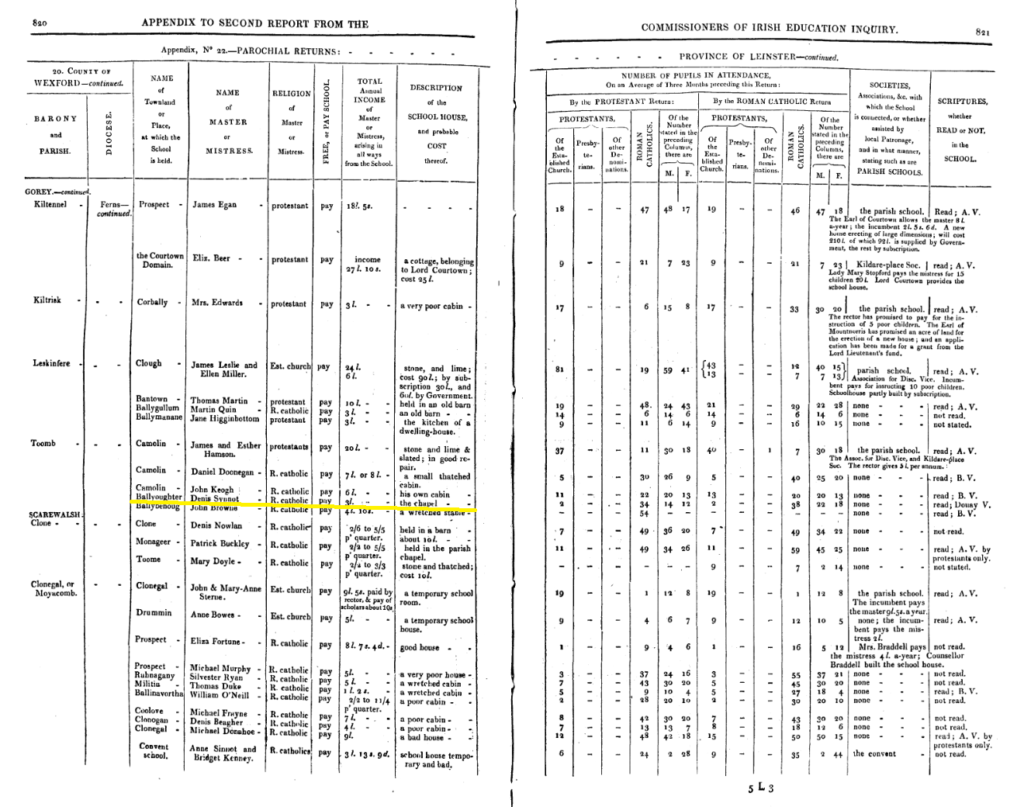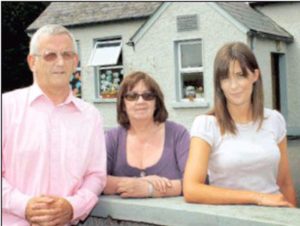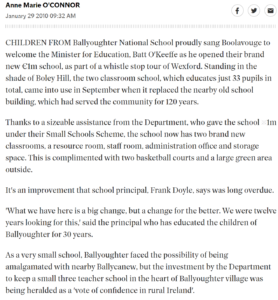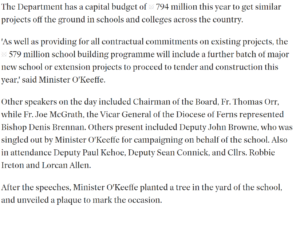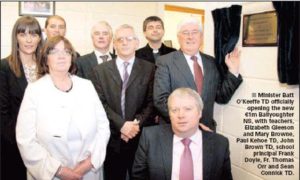Ballyoughter National School - 1800s to Present
The earliest historical records show that there was a school in Ballyoughter as far back as 1824 when a Roman Catholic school operated out of the local chapel. The teacher in charge was Denis Synnot and he earned an annual salary of £3. Very little else is known about this school or its teacher.
Local folklore suggests that this school replaced a ‘hedge school’ (scoil scairte) operating in the area. The easing of the Penal Laws on Education (1782) and the British government’s decision to introduce the National School System (1831) led to the closure of approximately 9,000 schools nationwide over a decade. A description of a typical hedge school and how it operated is recorded on the Dúchas.ie website and can be viewed here.
In the Griffith’s Valuation of 1853, there is a record of a school in a house on the land of Rev. William Purcell. This record and the location map can be viewed at The Past/Griffith’s Valuation.
In 1872, a school was built on land rented from Lord Courtown (5th Earl of Courtown, James George Henry Stopford) for the princely sum of one penny per year with the understanding that it was to be a multi-denominational school. It had a clay floor and the teacher, Ms Alice O’Neill, lived in the school upon her appointment on 1st March 1872. Ms O’Neill was paid a salary of €14 per year and had previously been employed for four years in Clologue National School.
A week after Ms O’Neill’s appointment, the school manager, Rev R. Williams CC applied to the Board of Education for sanction of the building as a state-approved school. The application was rejected as the building had a clay floor, only two small windows and no form of heating. A 17-year battle with the state by Rev. Williams’ successors, Rev Robert Sinnott (1875-1886) and Rev. Thomas Staples, for recognition was eventually successful.
Rev. Staples borrowed £240 from the bank for the upgrading of the school building between 1886 and 1889 and the loan was to be repaid at £20 per year. Numerous applications were made to the Board of Education for recognition as a National School. The clay floor was replaced with concrete with desks embedded in the floor. This was rejected as unsuitable by the Board of Education, and Rev. Staples had to remove the concrete and install floorboards. Three new windows were installed alomg with a new stove, a teacher’s desk, a blackboard and additional pupil desks. All this work eventually paid off and the school was granted state approval in 1889.
This newly approved one-classroom school measured 37′ by 15′. According to archival roll books, the school officially opened its doors on 7th April 1890. There were a total of seven forms/desks, each measuring 9′ each, two 4′ and one 14′ 9″ desk.
The school building came in for a mixture of praise and criticism from the District Inspector, Mr W MacMillan, in his report of 7th March 1891. He noted that ‘A house satisfactory in every way, except that it has not a boarded floor, has been built at Ballyoughter to take the place of one of the worst in the district.’ Records show the school was opened six days a week in the 1890s with school on Saturday morning from 10am to noon.
A fireplace and a chimney were added in 1907 when a teaching assistant was employed for the first time.
The Gaelic League Organiser’s Report from 1912 wrote ‘Ballyoughter (Máiréad Nic Giolla Eoin, principal; Síle Ní Bhréanáin, assistant) – The work done in this school is excellent. All are taught Irish. The language is used generally by teachers and pupils in all school work. Their prayers and songs are in Irish. The tone of the school is inspiring. Some of the children are native Irish speakers’.
A second classroom was added in 1948 for junior classes to accommodate growing numbers of pupils. At the same time, running water and flushing toilets were installed. This provision was well ahead of its time for a rural school. The work was carried out under the direction of Rev. James Canon Doran, P.P. In 1976, a central heating system was added and, in 1984, a toilet block and staff room were built.
The school celebrated its centenary in 1989 at a mass led by Dr. Brendan Comiskey, SS CC and Fr. Joseph Kavanagh C.C. A specially commissioned plaque was unveiled at the event and is visible at the entrance to the school building.
The ‘old’ building was unable to meet the demands of a modern 21st century education system and was closed at the end of the school year in 2009. It was replaced by a new ‘state-of-the-art’ school built on parish lands which were purchased by the Department of Education. The school was operational the following September and officially opened on the 22nd of January 2010.
The new school has two classrooms, an administration office, a staff room, a medical room, a learning support room, and showers and toilets. It also has more than three quarters of an acre of playing space.
In 2020, during the Covid-19 pandemic, Ballyoughter NS was granted additional accommodation by the Department of Education and Skills. The extension consists of one mainstream classroom including ensuite toilets and one WC for assisted users along with one Special Education Teaching room.
When the new school was opened in 2010, consideration was given to naming the school after a Saint. This name change never materialised but the idea was resurrected upon the opening of the school extension. The Principal, Pádraig O’Connor, conducted a survey with the school’s parent body and with the Board of Management. The result of the survey was to leave the name unchanged. The overwhelming sentiment was that the school’s current name was inextricably linked with the history of Ballyoughter and this association was too important to relinquish.
This photograph is of the single classroom school built in 1889. Note the plaque on the external wall of the entrance hall with the inscription 1889 and the sign, Ballyoughter National School, on the top right corner of the building.
Note the flag flying from a wooden pole on top of the porch. The colours are not know for certain but are likely to be either black and amber (original parish colours) or purple and amber (original county colours). Today purple and gold is the colour of both parish and county.
The ridge tiles are noteworthy in that they match the ridge tiles used on the church a decade earlier. The windows flip on a central axis allowing for maximum ventilation, a design feature implemented to reduce the spread of infectious disease among the pupil body.
Official Opening of new National School
Planning details for the new school (2007) and extension (2020)
Review the planning documents for Ballyoughter National School (2007) and the subsequent extension (2020).
Use the ‘4-way arrow’ icon to view fullscreen, then enlarge as required using the zoom feature.
Ballyoughter National School planning documents are provided courtesy of Nicholas Mernagh Architects, Mullanour, Rosslare, County Wexford, Y35EA39.



